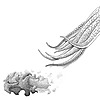HOME | DD
 Ictonyx — Bear family tree
Ictonyx — Bear family tree

#american #americanus #arctos #asian #asiatic #bear #black #brown #carnivora #cave #maritimus #panda #polar #simus #spectacled #spelaeus #ursinus #ursus #ornatus #phylogeny #tremarctos #ailuropoda #arctodus #ursidae #helarctos #malayanus #melursus #thibetanus #tremarctinae #ursinae #ailuropodinae
Published: 2016-04-26 16:51:27 +0000 UTC; Views: 4306; Favourites: 30; Downloads: 3
Redirect to original
Description
A basic bear phylogeny, to show postulated relationships between the living bear species, and to make a point about reconstructing the colour of extinct animals.
The relationships of the eight living bears as depicted here follows Pàges et. al. (2008). The panda is the most basal, then the spectacled bear (represented here alongside the giant extinct tremarctine, Arctodus simus). All the other bears in the tree are ursine bears. There is a strong consensus on this much. The branching order of the ursine bears is much more up in the air.
Pàges et. al. (2008) found the sun bear to be the most basal ursine bear, then the sloth bear; some would have this the other way round, and I have even seen the sun bear grouped in a clade with the two black bears. Pàges has the four living species typically placed in the genus Ursus as forming a clade, with the Asian black bear as the most basal, then the American black bear.
The clade formed by the brown and polar bear is a good example of how the human desire to pigeon-hole and categorise falls short of representing reality. In actual fact, the polar bear falls ‘within’ the brown bear group. Polar bears evolved from brown bears, and this happened so recently that some brown bears living today (specifically the brown bears of Alaska’s ABC islands) are more closely related to polar bears than to other brown bears. If we wanted to be as scientifically neat as possible, we should lump polar bears into Ursus arctos and think of them as a variety of brown bear. Or should we? After all, most speciation events presumably occur in this manner; there will be a period of awkward not-quite-separation. I think everyone would accept that the polar bear’s morphology and ecology are sufficiently distinct from the brown bear’s to warrant its own specific name, Ursus maritimus; it’s one of those times where convenience supercedes imposed taxonomy.
The extinct cave bear is considered the sister species to the brown bear, completing the tree shown here. I would have liked to include one of the big ‘ursavine’ bears – Agriotherium or Indarctos – but there doesn’t seem to be anything approaching a consensus on their relationships.
Onto the colour point – this follows on from the description of my cave bear sketch. Let’s say, for argument’s sake, the phylogeny of living bears proposed by Pàges et. al. (2008) is accurate. The following points could then be made:
1) The two basalmost bears (panda and spectacled) have some sort of face mask.
2) The basal ursine bears (sun, sloth and Asian black) follow a strict colour theme; black (excepting rare colour morphs) with contrasting light muzzles and U or V shaped chest patches.
3) The more derived American black bear is usually black (but brown is not unusual) with a contrasting light muzzle, and often has a white chest patch when young, but this typically fades as it grows up.
4) The most derived ursine bears (brown and polar) have uniform coats (more or less).
Also note that many of the close living relatives of bears (e.g. racoons, coatis, badgers, skunks) have striking face masks like the basalmost living bears. And the fact that the American black bear is not uncommonly brown, while this is rare for the Asian black bear and virtually unheard of (?) for more basal ursines. And the fact that American black bears often have white chest patches as cubs, but these typically fade away by adulthood. Also, brown bear cubs often show light collars. The idea of juvenile coat patterns harking back to an ancestral condition is not a new one; the rosettes on lion and puma cubs are pretty widely accepted to hint at ancestral coat patterns.
It seems that a fairly neat pattern may be present; basal bears had face masks (perhaps inherited from a common ancestor with procyonids etc.?), basal ursines were black with light muzzles and big light chest patches, these chest patches reduced and finally disappeared, and lighter base colours began to appear alongside the black. Imagine how neat it would be if cave bears were chromatically ‘in between’ American black and brown bears; perhaps half the population brown, half black, cubs with light chest patches or collars, weakly contrasting muzzles.
This pattern of coat colour evolution provides a basis for making educated guesses about the colour of extinct bears. I have depicted Arctodus simus as black with a contrasting face mask, because of its close living relative the spectacled bear, and I have depicted the cave bear as black with a contrasting light muzzle because that’s what four out of six living ursine bears look like. And that six is counting the polar and brown as separate when in fact the polar evolved directly from the brown; for all we know, the evolution of a lighter coat (rather than black, and not counting atypical colour morphs) may have only occurred once in the ursine line (in the brown bear).
Related content
Comments: 5

👍: 0 ⏩: 0

Thanks, and thanks for the favourite!
👍: 0 ⏩: 0

Newman et al. 2005 posited that facial masks may actually be an antipredator defense, namely aposematic coloration. It is even tentatively postulated that facial masks in select ursids may have evolved to deter predators such as tigers or even Smilodon.
👍: 1 ⏩: 1

Interesting, thanks for the comment.
👍: 0 ⏩: 0


















